Celebrating KY 4-H History in the 1940s
The Fourth Decade
While the concept of 4-H as dedicated to the development of the total youth was a new idea in the twenties, it came to full bloom with the incoming fourth decade. According to J.W. Whitehouse, then the State Leader of 4-H Clubs, the objective of 4-H work was to
…provide opportunities for farm boys and girls to develop themselves to successfully meet the economic and social conditions on the farm. Through their group action they learn to work and play together for the good of the individuals and the community; and through their project work to produce economically, and to market their products according to standard grades for best returns. 1
The emphasis on total youth development did not change–nor did it wane—but like everything else in our country, its importance paled in the shadow of World War II and its demands on the ingenuity and resources of our people. Woodrow Wilson was wrong, unfortunately, and the World War (now known as World War I) was not the war to end all wars.
As before in the time of war, depression, drought and flood, Extension—including 4-H—rolled up its sleeves and rose to the occasion. Patriotism was high during those war years; the enemy was clearly defined and our country united in its zeal to win “The War.”
Membership in 4-H jumped from 40,769 in 1941 to 105,825 by 1943. Even with such a dramatic increase in enrollment, 83.4 percent of projects started were completed. This phenomenal increase in membership, along with the very respectable percentage of projects completed, is a tribute to the members’ personal determination to help see the war ended.
In answer to the 1943 national membership drive theme, “Feed a Fighter in ’43,” 4-H members grew “Victory Gardens” to produce and conserve food. Canning clubs thrived. 4-H’ers collected scrap metal and worked to provide farm labor shortage relief. Some members even collected milkweed pods to be used in making life jackets (kapok from Indonesia was no longer available for this purpose).
The end of the war saw 4-H stronger than ever before, even though the peak membership declined after the war to 66,060 in 1949. This year was a milestone, however, when total 4-H membership from its beginning reached 500,000–one-half million.
Organization of the 4-H Club
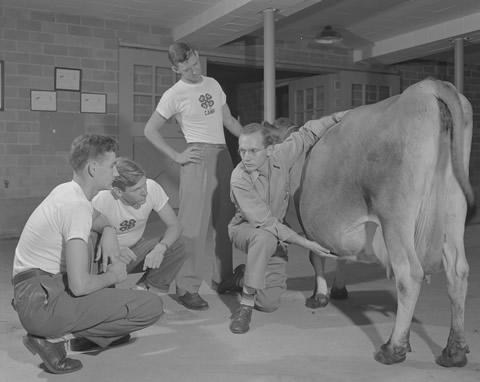
Guide Posts for Local 4-H Leaders was written by T. A. Erickson and published in 1941 (3rd edition) by General Mills, Inc. Erickson gathered information from a number of states, then compiled this handbook to be used across the country. He had served as State 4-H Leader in Minnesota from 1912 to1940 but at the time of the writing, he was a consultant for General Foods, Inc. General Mills paid for the publication for 4-H. More... 2
In 1941, there were two types of 4-H clubs—Project Clubs and Community Clubs. All members of the project club carried the same project. Erickson stated, “The project club has the advantage of unity and simplicity in doing strong project work.” Community clubs were made up of both boys and girls working on several different projects but all organized into one club. Each project group within the community club was led by a project leader who acted as an assistant to the club leader. Project groups met in addition to the community club meetings. Erickson continues, “The community club has the advantage, by bringing a larger group of young people together, of holding programs and activities of more general interest than the small groups. More inspirational, social and recreational activities can be carried out which lead to a higher club spirit and higher ideals. Such an organization provides more opportunity for committee work and beneficial service to the community.”
According to Erickson, to be a “standard 4-H club,” the club had to meet the following requirements:
1. Five or more members in one club project. Additional members may represent other projects.
2. A local leader in charge who is general adviser.
3. A club organization with its own officers having charge of business meetings.
4. A program of work for the year.
5. At least six meetings during the year and goals 6-9.
6. A judging contest during the year.
7. A demonstration team giving at least one public demonstration locally.
8. An exhibit of club work.
9. An Achievement Day (the finish-up).
10. At least 60 percent of the members filing final reports.
When the first four goals were completed, a “Standard Club Charter” was issued. When all ten were attained, the Achievement Seal was awarded to the club.
Participation by Black Youth
Clubs involving black youth continued to grow: in 1941 there were 2,240 black members; 2,707 in 1942 and 3,255 by 1949. The Rural Youth Conference for 4-H was held at Kentucky State College and the State Camp for black youth was held at Fee Memorial Institute in Jessamine County in 1946 and at Lincoln Ridge in Shelby County in 1949.
The 1948 annual Extension report indicates that six black members attended the Regional Camp in Louisiana.
Activities
Camping—Although wartime activities were the major thrust during the war years, regular 4-H activities were not necessarily displaced.
Camping had received a big boost just prior to the war when Barry Bingham, publisher of the Louisville Courier Journal and Louisville Times donated $10,000 to the university for the purpose of obtaining the old Tatum Springs summer resort property in Washington County to be renovated for a 4-H camp. The money, along with other donations, provided camping facilities to accommodate 230 club members and leaders. The renovation of the new Bingham Camp was completed by the fall of 1941.
For the first time the camp had a full-time cook. The Chaplin River provided a place to swim. The YWCA sent a person to teach recreation classes.
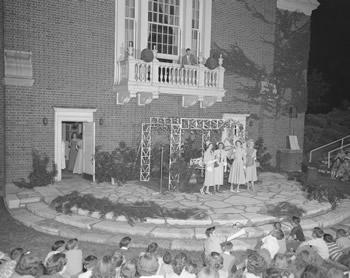
Camping continued all during the war years, although there was a slight decline in numbers attending. It is intThe Style Show was held during Junior Week behind Memorial Halleresting to note that in 1942 the Purchase Camp at Columbia Park was called off because of “infantile paralysis” (polio), and the Morehead Camp was cancelled because the navy was using the school grounds. During the years 1943 and 1944, the 4-H camp was referred to as “Wartime Conference.”
After the war, Kentucky Utilities entered the camping scene by starting an electricity class.
In 1948, 2,449 members camped in 14 district camps. More...
Utopia Clubs—Utopia Clubs were still alive and well and, according to the records, there was a Utopia Camp in 1946 at Bingham Camp with 95 members, 13 agents and nine instructors attending the camp. At the end of the decade, there were 887 Utopia members in 26 counties. More…
Junior Week—The popular Junior Week had to be cancelled from 1943 to 1945 after its successful 1942 “Mobilized for Victory” session was attended by 714 members from 107 counties. This event resumed in 1946, and in 1947 the name was changed to 4-H Week. In 1949, 1,018 county champion members attended.
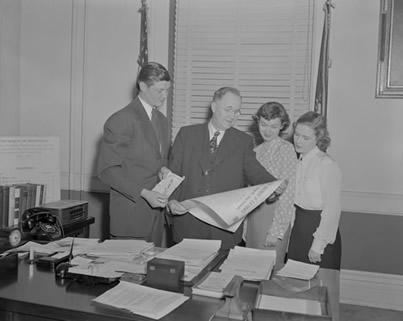
National 4-H Club Camp— The National 4-H Club Camp trip was the highest honor given in 4-H club work, according to T. A. Erickson. Each state selected “four of the finest 4-H members from the state” to attend. Members attended conferences and visited points of historical and educational interest. They camped out in tents at the foot of the Washington Monument. It was held annually during the third week of June in Washington, D.C. (3) This camp was closed for four war years, but Kentucky sent its quota of delegates when it reopened in 1946.
National 4-H Club Congress—Congress was held in Chicago annually. This activity apparently was not curtailed during the war and was referred to in the records as the Wartime 4-H Club Congress. Reference was made in the 1946 Annual Extension report to expenses of champions being paid by friends of 4-H Club work (and here we have a forerunner to today’s Kentucky 4-H Foundation). “Besides competing in various contests, clubsters who attend this meeting have an opportunity to see the International Live Stock Show, the International Hay and Grain Show, and the city of Chicago—through well-planned educational tours,” according to T. A. Erickson. (4) More...
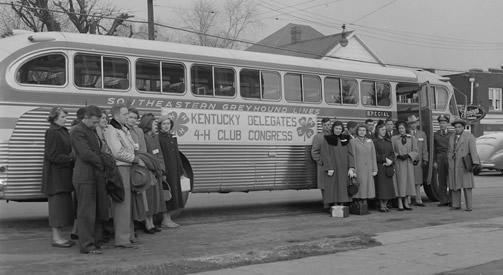
Market Live Shows—These shows continued with excellent participation. In 1942, the grand champion lamb of the Bluegrass Lamb Show was sent to the President of the United States–certainly a memorable experience for the owner of the lamb.
Projects—Traditional 4-H projects remained popular and in 1949 the following projects had the largest participation:
Clothing—24,678
Home Gardening—8,563
Canning—8,350
Foods—7,688
Swine—5,671
Tobacco—5,028
Corn—4,488
Dairy Cattle—3,011
Beef—2,992
Demonstrations—From the early years, demonstrations have been a primary means of sharing what one learned in 4-H. T. A. Erickson, in the 1941 edition of Guide Posts for Local 4-H Leaders, lists 20 points for a good demonstration.
1. Make it simple, practical, and complete.
2. Demonstrate only one subject. Emphasize few rather than many points.
3. Know subject material. (Do not memorize; do not lecture.)
4. Each member of the team should have a talking and helping part. Strive for teamwork.
5. Co-ordinate the action with the explanation.
6. Charts, if used, should be easily seen, displayed one at a time and only when being used.
7. Use only the latest approved practices.
8. Be thoroughly interested in topic.
9. Be courteous, cheerful, and enthusiastic.
10. Stand erect; look the audience squarely in the eyes.
11. Conduct all steps in demonstration in plain view.
12. Be neat in all your work.
13. Speak distinctly and loudly enough to be heard by entire audience.
14. Use simple, but good, language.
15. Use personal experiences when possible. Avoid giving advice.
16. Give enough subject matter to explain each step in the demonstration.
17. Summarize main points.
18. Encourage audience to ask questions after you have finished demonstrations.
19. Answer questions completely and courteously.
20. Unity, simplicity, practicability, and activity—the 4 Y’s of 4-H demonstration. (5)
More...
Rethinking Organizational Structure
The distinction between farm and rural youth became less distinct in the late thirties and early forties as rural schools consolidated. Although consolidation provided a good setting for reaching more young people, it presented some problems for agents.
For one thing, consolidation meant a more tightly constructed school curriculum, which tended to push 4-H into an increasingly smaller block of time–often too little to complete meetings and project instruction. In addition, leaders often were required to travel farther, and agents were picking up the slack of some volunteers who found themselves less able to act as leaders.
To overcome this kink in what had been a well-oiled machine of cooperation between Extension and the school system, 4-H moved toward more after-school community clubs.
Soon other counties enrolled suburban students in county school systems and 4-H became a youth organization serving young people from urban and suburban areas–as well as the farm.
Projects and activities gradually reflected this enlarged audience. Projects such as automotive, woodworking, rabbits, forestry, home grounds beautification, entomology and others came on the scene to meet the needs of non-rural as well as rural and farm members.
Leadership
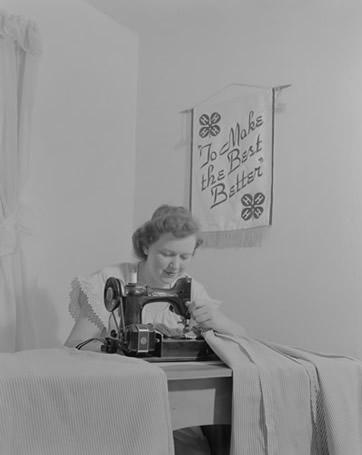
Because more clubs were being organized outside of school, emphasis was placed on recruiting leaders who possessed certain qualifications. According to Guide Posts for Local 4-H Leaders (a national publication), leaders should possess the following seven qualifications:
1. Liked and respected by parents and community.
2. Sincere liking for boys and girls.
3. Strict standards for sportsmanship and honesty.
4. Enthusiastic about 4-H Club work.
5. Good cooperator, works well with others.
6. Liked by boys and girls.
7. Unselfish—enjoys working with others.
Other qualities also listed as needed in order to be successful:
1. Plans work ahead.
2. Good teacher—encourages others to learn.
3. Good organizer—likes to work with groups.
4. Knows subject matter to be taught.
5. Perseverance—slow to give up.
6. Gets others to help and assume responsibility. (6)
County 4-H Associations—One new addition referred to in the 1948 Extension report was that of county 4-H associations, organized to train and involve project leaders. These associations were to provide leaders, a man and a woman, in each neighborhood to ensure the necessary leadership for 4-H. County 4-H associations were to help purchase 4-H project materials, procure calves for members and in other ways help implement the 4-H program. These associations were replaced by county 4-H councils around 1953.
Recognition—This decade saw a growth in leadership with 1949, the peak year, reporting 9,151 leaders. Recognizing leaders with certificates, pins and banquets was then and continues to be a principle by which the Cooperative Extension Service expresses appreciation to its volunteer leaders.
International Farm Youth Exchange
With the end of the World War II, Americans were anxious to build world peace and understanding. The International Farm Youth Exchange was created to foster relationships between young people of the United States and European countries. 4-H youth spent one to six-months living with a family in another country. Kentucky got involved with IFYE in 1949. Kentucky’s first participants (1949) were Charles C. Bastin of Jefferson County and Alice Word of Christian County. Bastin spent six months in Britain and Word in Denmark.
These young people lived with farm families, learning from and sharing with their host families just as European youth who came to the United States did with Kentucky host families. Upon returning home, the young people shared their experiences through presentations to various groups. The IFYE program still is an important part of Kentucky 4-H although it has not been one that has seen continuous participation. Between 1949 and 1976, 75 Kentucky 4-H’ers had lived in 37 different countries. In addition, 350 Kentucky families had hosted more than 125 IFYE’s from 46 different countries around the world.
District Events
As participation in 4-H grew, so did the need for a level of events between the county and state levels. The gasoline shortage during the war years restricted travel by agents–as well as members and leaders. In 1943, district project achievement days were held, and soon district dairy show, baby beef show, lamb shows and other district events became the 4-H’ers step from county to state events.
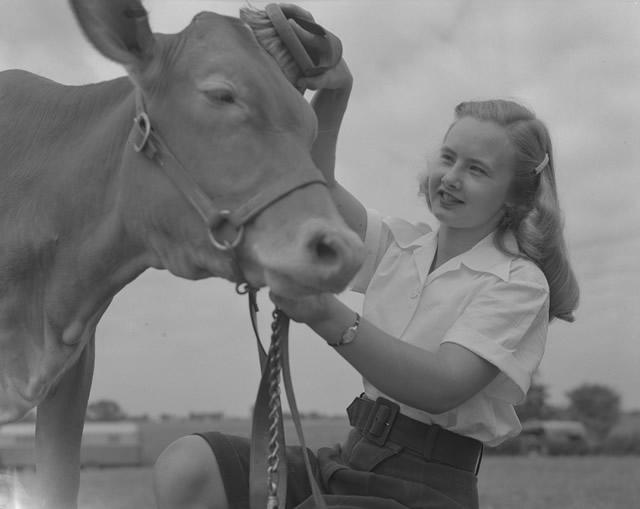
Recreation
Recreation for young people became a priority not only for 4-H but for adult Extension programs. Workshops were held for training leaders who were mostly 4-H Club leaders, older 4-H and Utopia boys and girls, homemakers, leaders, teachers, school principals and superintendents, athletic coaches and ministers.
State Staff
Still under the leadership of J.W. Whitehouse, Kentucky 4-H closed out its fourth decade. On the staff at this time were:
J.W. Whitehouse, State Leader for 4-H Clubs
Field Agents: E.E. Fish
M.S. Garside
Dorothy Gentry
H.B. Gibson
Margaret Gulley
Carl W. Jones
Edith Lacy
G.J. McKinney
Frank H. Smith
Lyda Mae Sutherland
Boyd Wheeler
